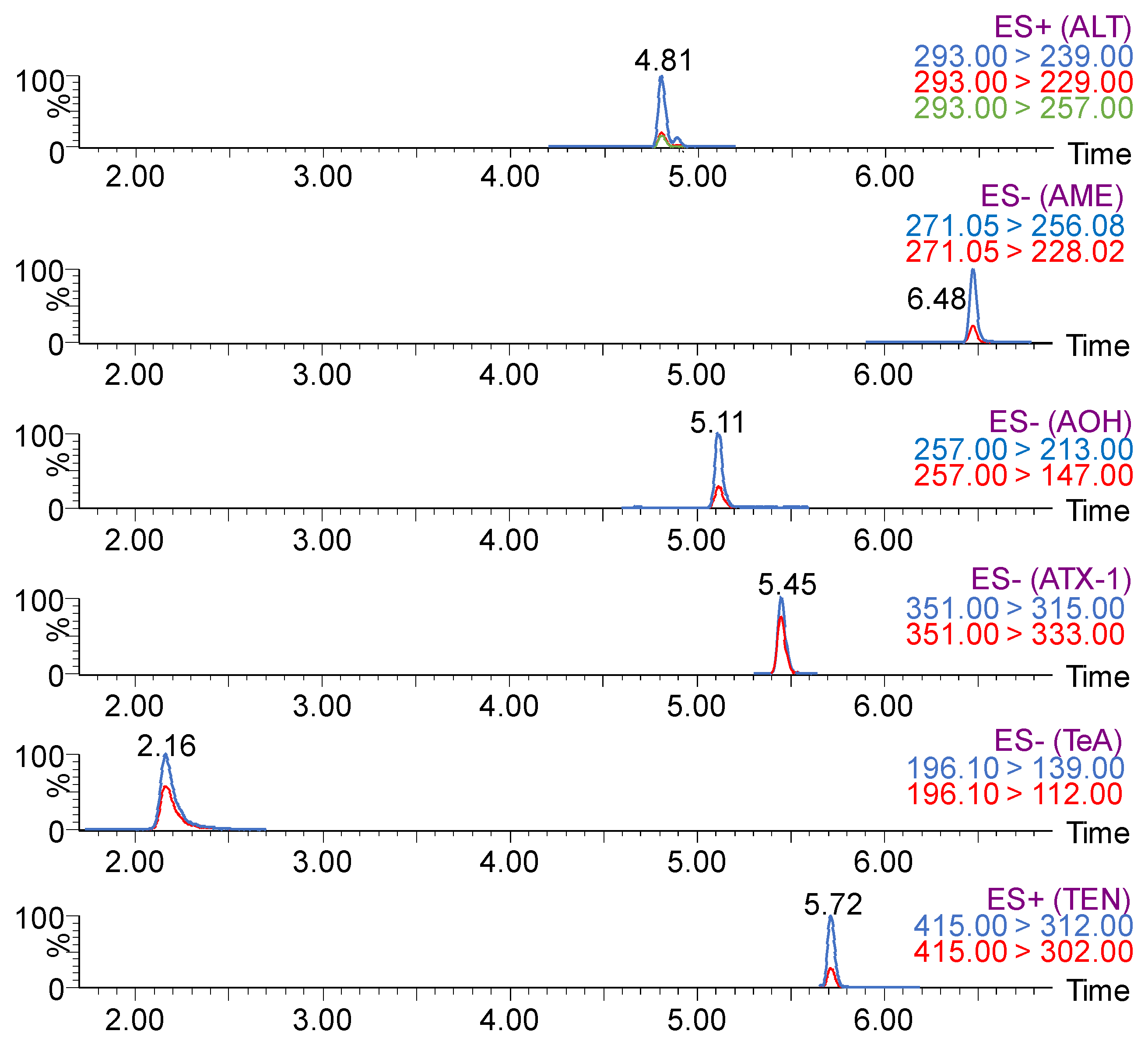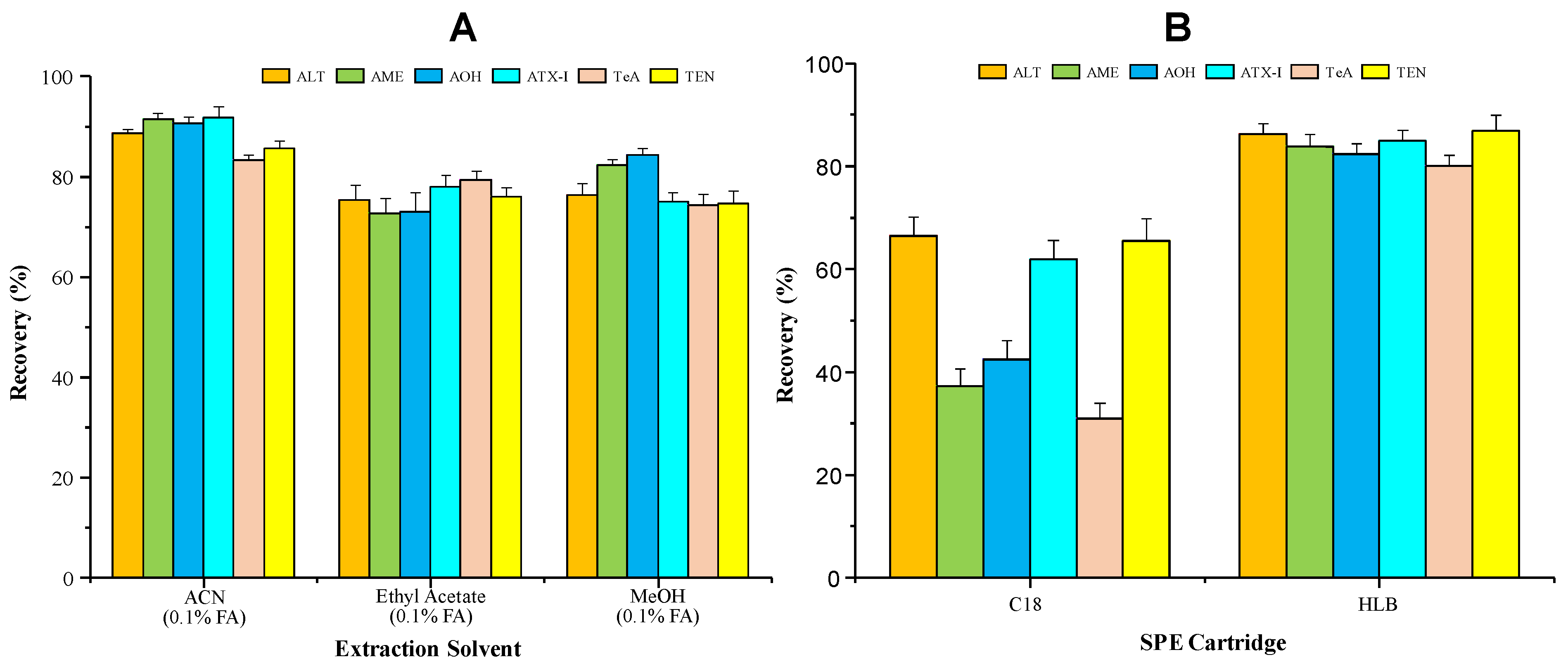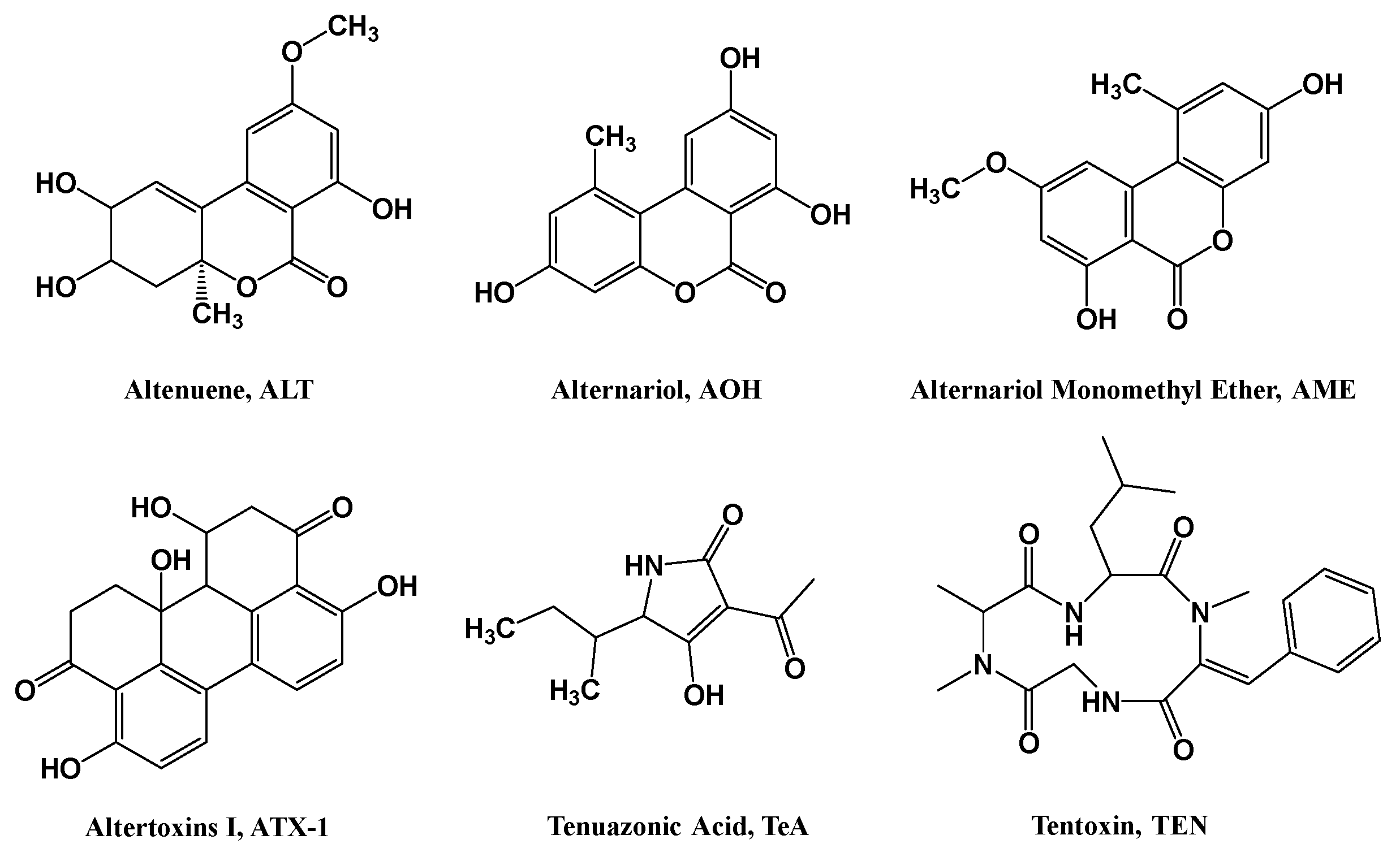Alternaria Mycotoxins Analysis and Exposure Investigation in Ruminant Feeds
Abstract
1. Introduction
2. Results and Discussion
2.1. Optimization of LC-MS/MS Conditions
2.2. Optimization of Extraction Procedure
2.3. Optimization of Purification Procedure
2.4. Method Validation
2.4.1. Selectivity
2.4.2. Linearity
2.4.3. Sensitivity
2.4.4. Accuracy and Precision
2.5. Exposure of Alternaria Mycotoxins in Ruminant Feeds
3. Conclusions
4. Materials and Methods
4.1. Chemicals and Reagents
4.2. Apparatus
4.3. Standard Solution Preparation
4.4. Sample Preparation
4.5. LC-MS/MS Parameters
4.6. Method Validation
4.7. Exposure Investigation of Alternaria Mycotoxins in Commercial Ruminant Feeds
Supplementary Materials
Author Contributions
Funding
Institutional Review Board Statement
Informed Consent Statement
Data Availability Statement
Conflicts of Interest
References
- DeMers, M. Alternaria Alternata as Endophyte and Pathogen. Microbiology 2022, 168, 001153. [Google Scholar] [CrossRef] [PubMed]
- Wang, H.; Guo, Y.; Luo, Z.; Gao, L.; Li, R.; Zhang, Y.; Kalaji, H.M.; Qiang, S.; Chen, S. Recent Advances in Alternaria Phytotoxins: A Review of their Occurrence, Structure, Bioactivity, and Biosynthesis. J. Fungi 2022, 8, 168. [Google Scholar] [CrossRef] [PubMed]
- Chen, A.; Mao, X.; Sun, Q.; Wei, Z.; Li, J.; You, Y.; Zhao, J.; Jiang, G.; Wu, Y.; Wang, L.; et al. Alternaria Mycotoxins: An overview of Toxicity, Metabolism, and Analysis in Food. J. Agric. Food Chem. 2021, 69, 7817–7830. [Google Scholar] [CrossRef] [PubMed]
- Aichinger, G.; Del Favero, G.; Warth, B.; Marko, D. Alternaria Toxins—Still Emerging? Compr. Rev. Food Sci. Food Saf. 2021, 20, 4390–4406. [Google Scholar] [CrossRef] [PubMed]
- Schoevers, E.J.; Santos, R.R.; Roelen, B.A.J. Alternariol Disturbs Oocyte Maturation and Preimplantation Development. Mycotoxin Res. 2020, 36, 93–101. [Google Scholar] [CrossRef]
- Kowalska, K.; Kozieł, M.J.; Urbanek, K.A.; Habrowska-Górczyńska, D.E.; Domińska, K.; Piastowska-Ciesielska, A.W. Estrogen Receptor β Participates in Alternariol-Induced Oxidative Stress in Normal Prostate Epithelial Cells. Toxins 2021, 13, 766. [Google Scholar] [CrossRef]
- Den Hollander, D.; Holvoet, C.; Demeyere, K.; De Zutter, N.; Audenaert, K.; Meyer, E.; Croubels, S. Cytotoxic Effects of Alternariol, Alternariol Monomethyl-Ether, and Tenuazonic Acid and Their Relevant Combined Mixtures on Human Enterocytes and Hepatocytes. Front. Microbiol. 2022, 13, 849243. [Google Scholar] [CrossRef]
- Crudo, F.; Varga, E.; Aichinger, G.; Galaverna, G.; Marko, D.; Dall’Asta, C.; Dellafiora, L. Co-Occurrence and Combinatory Effects of Alternaria Mycotoxins and other Xenobiotics of Food Origin: Current Scenario and Future Perspectives. Toxins 2019, 11, 640. [Google Scholar] [CrossRef]
- Fraeyman, S.; Croubels, S.; Devreese, M.; Antonissen, G. Emerging Fusarium and Alternaria Mycotoxins: Occurrence, Toxicity and Toxicokinetics. Toxins 2017, 9, 228. [Google Scholar] [CrossRef]
- Kumari, A.; Singh, K. Evaluation of Prophylactic Efficacy of Cinnamaldehyde in Murine Model Against Paradendryphiella Arenariae Mycotoxin Tenuazonic Acid-Induced Oxidative Stress and Organ Toxicity. Sci. Rep. 2021, 11, 19420. [Google Scholar] [CrossRef]
- Tang, X.; Chen, Y.; Zhu, X.; Miao, Y.; Wang, D.; Zhang, J.; Li, R.; Zhang, L.; Chen, J. Alternariol Monomethyl Ether Toxicity and Genotoxicity in Male Sprague-Dawley Rats: 28-Day in vivo Multi-Endpoint Assessment. Mutat. Res./Genet. Toxicol. Environ. Mutagen. 2022, 873, 503435. [Google Scholar] [CrossRef]
- Bertuzzi, T.; Rastelli, S.; Pietri, A.; Giorni, P. Alternaria Toxins in Tomato Products in Northern Italy in the period 2017–2019. Food Addit. Contam. Part B Surveill. 2021, 14, 170–176. [Google Scholar] [CrossRef]
- Leslie, J.F.; Moretti, A.; Mesterházy, Á.; Ameye, M.; Audenaert, K.; Singh, P.K.; Richard-Forget, F.; Chulze, S.N.; Ponte, E.M.D.; Chala, A.; et al. Key Global Actions for Mycotoxin Management in Wheat and Other Small Grains. Toxins 2021, 13, 725. [Google Scholar] [CrossRef]
- Ji, X.; Xiao, Y.; Lyu, W.; Li, M.; Wang, W.; Tang, B.; Wang, X.; Yang, H. Probabilistic Risk Assessment of Combined Exposure to Deoxynivalenol and Emerging Alternaria Toxins in Cereal-Based Food Products for Infants and Young Children in China. Toxins 2022, 14, 509. [Google Scholar] [CrossRef]
- Babič, J.; Tavčar-Kalcher, G.; Celar, F.A.; Kos, K.; Knific, T.; Jakovac-Strajn, B. Occurrence of Alternaria and Other Toxins in Cereal Grains Intended for Animal Feeding Collected in Slovenia: A Three-Year Study. Toxins 2021, 13, 304. [Google Scholar] [CrossRef]
- Gao, Z.; Zhong, W. Recent (2018–2020) Development in Capillary Electrophoresis. Anal. Bioanal. Chem. 2022, 414, 115–130. [Google Scholar] [CrossRef]
- Puntscher, H.; Kütt, M.; Skrinjar, P.; Mikula, H.; Podlech, J.; Fröhlich, J.; Marko, D.; Warth, B. Tracking Emerging Mycotoxins in Food: Development of an LC-MS/MS Method for free and Modified Alternaria Toxins. Anal. Bioanal. Chem. 2018, 410, 4481–4494. [Google Scholar] [CrossRef]
- Birr, T.; Jensen, T.; Preußke, N.; Sönnichsen, F.; Boevre, M.; Saeger, S.; Hasler, M.; Verreet, J.; Klink, H. Occurrence of Fusarium Mycotoxins and Their Modified Forms in Forage Maize Cultivars. Toxins 2021, 13, 110. [Google Scholar] [CrossRef]
- Biscoto, G.L.; Salvato, L.A.; Alvarenga, E.R.; Dias, R.R.S.; Pinheiro, G.R.G.; Rodrigues, M.P.; Pinto, P.N.; Freitas, R.P.; Keller, K.M. Mycotoxins in Cattle Feed and Feed Ingredients in Brazil: A Five-Year Survey. Toxins 2022, 14, 552. [Google Scholar] [CrossRef]
- Escrivá, L.; Oueslati, S.; Font, G.; Manyes, L. Alternaria Mycotoxins in Food and Feed: An Overview. J. Food Qual. 2017, 2017, 1569748. [Google Scholar] [CrossRef]
- Tian, M.; Feng, Y.; He, X.; Zhang, D.; Wang, W.; Liu, D. Mycotoxins in Livestock Feed in China-Current Status and Future Challenges. Toxicon 2022, 214, 112–120. [Google Scholar] [CrossRef] [PubMed]
- Commission Implementing Regulation (EU) 2021/808 on the Performance of Analytical Methods for Residues of Pharmacologically Active Substances Used in Food-Producing Animals and on the Interpretation of Results As Well As on the Methods to Be Used for Sampling and Repealing Decisions 2002/657/EC and 98/179/EC. Available online: https://leap.unep.org/countries/eu/national-legislation/commission-implementing-regulation-eu-2021808-performance (accessed on 22 March 2021).
- Dong, H.; Xian, Y.; Xiao, K.; Wu, Y.; Zhu, L.; He, J. Development and Comparison of Single-Step Solid Phase Extraction and Quechers Clean-Up for the Analysis of 7 Mycotoxins in Fruits and Vegetables During Storage by UHPLC-MS/MS. Food Chem. 2019, 274, 471–479. [Google Scholar] [CrossRef] [PubMed]
- Zhao, X.; Liu, D.; Yang, X.; Zhang, L.; Yang, M. Detection of Seven Alternaria Toxins in Edible and Medicinal Herbs Using Ultra-High Performance Liquid Chromatography-Tandem Mass Spectrometry. Food Chem. X 2022, 13, 100186. [Google Scholar] [CrossRef] [PubMed]
- Jaderson, M.; Park, J. Evaluation of Matrix Effects in Quantifying Microbial Secondary Metabolites in Indoor Dust Using Ultraperformance Liquid Chromatograph–Tandem Mass Spectrometer. Saf. Health Work 2019, 10, 196–204. [Google Scholar] [CrossRef] [PubMed]
- Pihlström, T.; Fernández-Alba, A.R.; Amate, C.F.; Poulsen, M.E.; Hardebusch, B.; Anastassiades, M. Guidance SANTE 11312/2021–Analytical Quality Control and Method Validation Procedures for Pesticide Residues Analysis in Food and Feed. Mutat. Res./Genet. Toxicol. Environ. Mutagen. 2021, 11312, 21–22. [Google Scholar]
- Desimoni, E.; Brunetti, B. About Estimating the Limit of Detection by the Signal to Noise Approach. Pharm. Anal. Acta 2015, 6, 1000355. [Google Scholar]
- European Commission, Joint Research Centre; Wenzl, T.; Haedrich, J.; Schaechtele, A.; Robouch, P.; Stroka, J. Guidance Document on the Estimation of LOD and LOQ for Measurements in the Field of Contaminants in Feed and Food. Publications Office. 2016. Available online: https://data.europa.eu/doi/10.2787/8931 (accessed on 21 October 2016).
- Myresiotis, C.K.; Testempasis, S.; Vryzas, Z.; Karaoglanidis, G.S.; Papadopoulou-Mourkidou, E. Determination of Mycotoxins in Pomegranate Fruits and Juices using a QuEChERS-Based Method. Food Chem. 2015, 182, 81–88. [Google Scholar] [CrossRef]
- Monbaliu, S.; Van Poucke, K.; Heungens, K.; Van Peteghem, C.; De Saeger, S. Production and Migration of Mycotoxins in Sweet Pepper Analyzed by Multimycotoxin LC-MS/MS. J. Agric. Food Chem. 2010, 58, 10475–10479. [Google Scholar] [CrossRef]
- De Girolamo, A.; Ciasca, B.; Stroka, J.; Bratinova, S.; Pascale, M.; Visconti, A.; Lattanzio, V.M. Performance Evaluation of LC–MS/MS Methods for Multi-Mycotoxin Determination in Maize and Wheat by Means of International Proficiency Testing. TRAC-Trend Anal. Chem. 2017, 86, 222–234. [Google Scholar] [CrossRef]
- Xu, W.; Han, X.; Li, F.; Zhang, L. Natural occurrence of Alternaria toxins in the 2015 wheat from Anhui province, China. Toxins 2016, 8, 308. [Google Scholar] [CrossRef]
- Lattanzio, V.M.; Verdini, E.; Sdogati, S.; Bibi, R.; Ciasca, B.; Pecorelli, I. Monitoring Alternaria toxins in Italian food to support upcoming regulation. Food Addit. Contam. B 2022, 15, 42–51. [Google Scholar] [CrossRef] [PubMed]
- Lan, F.; Jiang, F.; Zang, H.; Wang, Z. Saturated Brine Dissolution and Liquid–Liquid Extraction Combined with UPLC–MS/MS for the Detection of Typical Alternaria Toxins in Pear Paste. J. Sci. Food. Agric. 2023. Online ahead of print. [Google Scholar] [CrossRef] [PubMed]
- Qiao, X.; Yin, J.; Yang, Y.; Zhang, J.; Shao, B.; Li, H.; Chen, H. Determination of Alternaria Mycotoxins in Fresh Sweet Cherries and Cherry-Based Products: Method Validation and Occurrence. J. Agric. Food Chem. 2018, 66, 11846–11853. [Google Scholar] [CrossRef] [PubMed]



| Mycotoxin | Ionization Mode | Precursor (m/z) | Product (m/z) | Dwell (s) | Cone Voltage (V) | Collision Energy (eV) |
|---|---|---|---|---|---|---|
| ALT | ESI+ | 293.00 | 229.00 | 0.016 | 33.0 | 20.0 |
| 239.00 * | 25.0 | |||||
| 257.00 | 15.0 | |||||
| AME | ESI− | 271.05 | 228.02 | 0.039 | 30 | 30.0 |
| 256.08 * | 22.0 | |||||
| AOH | ESI− | 257.00 | 147.00 | 0.022 | 64.0 | 32.0 |
| 213.00 * | 24.0 | |||||
| ATX-Ⅰ | ESI− | 351.00 | 315.00 * | 0.135 | 20.0 | 15.0 |
| 333.00 | 10.0 | |||||
| TeA | ESI− | 196.10 | 112.00 | 0.080 | 52.0 | 24.0 |
| 139.00 * | 18.0 | |||||
| TEN | ESI+ | 415.00 | 302.00 | 0.039 | 40.0 | 18.0 |
| 312.00 * | 18.0 |
| Matrix | Mycotoxin | Linear Regression | Linear Range (ng/mL) | R2 | LOD (µg/kg) | LOQ (µg/kg) |
|---|---|---|---|---|---|---|
| Cattle Feed | ALT | y = 1267 x + 7908 | 2.0–500.0 | 0.9963 | 0.316 | 1.052 |
| AME | y = 2096 x − 3561 | 2.0–500.0 | 0.9988 | 0.356 | 1.184 | |
| AOH | y = 1954 x − 7781 | 2.0–500.0 | 0.9994 | 0.320 | 1.064 | |
| ATX-Ι | y = 2986 x + 5319 | 2.0–500.0 | 0.9969 | 0.193 | 0.641 | |
| TeA | y = 2148 x + 3501 | 2.0–500.0 | 0.9949 | 0.565 | 1.880 | |
| TEN | y = 1124 x + 5482 | 2.0–500.0 | 0.9983 | 0.147 | 0.488 | |
| Sheep Feed | ALT | y = 804 x + 1528 | 2.0–500.0 | 0.9958 | 0.272 | 0.906 |
| AME | y = 998 x + 1506 | 2.0–500.0 | 0.9939 | 0.452 | 1.505 | |
| AOH | y = 1051 x + 1122 | 2.0–500.0 | 0.9967 | 0.393 | 1.309 | |
| ATX-Ι | y = 1280 x + 1597 | 2.0–500.0 | 0.9979 | 0.168 | 0.560 | |
| TeA | y = 797 x + 2510 | 2.0–500.0 | 0.9938 | 0.548 | 1.825 | |
| TEN | y = 1148 x + 2548 | 2.0–500.0 | 0.9927 | 0.167 | 0.556 |
| Mycotoxin | Matrix | Fortified Level (µg/kg) | Mean Recovery (%) | RSDr % (n = 6) | RSDwr % (n = 3) | Matrix | Fortified Level (µg/kg) | Mean Recovery (%) | RSDr % (n = 6) | RSDwr % (n = 3) |
|---|---|---|---|---|---|---|---|---|---|---|
| ALT | Cattle Feed | 5 | 91 | 8 | 4 | Sheep Feed | 5 | 86 | 9 | 6 |
| 10 | 94 | 5 | 2 | 10 | 91 | 12 | 9 | |||
| 20 | 100 | 8 | 4 | 20 | 86 | 7 | 3 | |||
| AME | 5 | 96 | 9 | 5 | 5 | 92 | 7 | 3 | ||
| 10 | 85 | 10 | 7 | 10 | 81 | 12 | 9 | |||
| 20 | 82 | 9 | 6 | 20 | 94 | 9 | 5 | |||
| AOH | 5 | 85 | 6 | 2 | 5 | 83 | 9 | 5 | ||
| 10 | 89 | 10 | 7 | 10 | 96 | 9 | 6 | |||
| 20 | 85 | 8 | 5 | 20 | 88 | 10 | 7 | |||
| ATX-Ι | 5 | 93 | 6 | 3 | 5 | 76 | 10 | 5 | ||
| 10 | 88 | 5 | 1 | 10 | 86 | 8 | 4 | |||
| 20 | 95 | 7 | 3 | 20 | 78 | 7 | 4 | |||
| TeA | 5 | 78 | 9 | 5 | 5 | 85 | 9 | 5 | ||
| 10 | 84 | 10 | 6 | 10 | 85 | 8 | 5 | |||
| 20 | 91 | 6 | 2 | 20 | 91 | 9 | 5 | |||
| TEN | 5 | 82 | 8 | 4 | 5 | 80 | 9 | 5 | ||
| 10 | 91 | 7 | 4 | 10 | 99 | 7 | 3 | |||
| 20 | 96 | 7 | 4 | 20 | 89 | 10 | 7 |
| Feeds | Mycotoxin | Positive | Concentration (µg/kg) | Median (µg/kg) |
|---|---|---|---|---|
| Cattle | ALT | 0 | ND | ND |
| AME | 60% | 39~238 | 180 | |
| AOH | 75% | 22~196 | 156 | |
| ATX-Ι | 10% | 4~9 | 6 | |
| TeA | 60% | 56~295 | 189 | |
| TEN | 50% | 4~39 | 22 | |
| Sheep | ALT | 0 | ND | ND |
| AME | 75% | 62~481 | 396 | |
| AOH | 65% | 66~386 | 255 | |
| ATX-Ι | 15% | 6~15 | 8 | |
| TeA | 50% | 87~551 | 450 | |
| TEN | 40% | 8~142 | 82 |
Disclaimer/Publisher’s Note: The statements, opinions and data contained in all publications are solely those of the individual author(s) and contributor(s) and not of MDPI and/or the editor(s). MDPI and/or the editor(s) disclaim responsibility for any injury to people or property resulting from any ideas, methods, instructions or products referred to in the content. |
© 2023 by the authors. Licensee MDPI, Basel, Switzerland. This article is an open access article distributed under the terms and conditions of the Creative Commons Attribution (CC BY) license (https://creativecommons.org/licenses/by/4.0/).
Share and Cite
Mao, X.; Chen, W.; Wu, H.; Shao, Y.; Zhu, Y.; Guo, Q.; Li, Y.; Xia, L. Alternaria Mycotoxins Analysis and Exposure Investigation in Ruminant Feeds. Toxins 2023, 15, 495. https://doi.org/10.3390/toxins15080495
Mao X, Chen W, Wu H, Shao Y, Zhu Y, Guo Q, Li Y, Xia L. Alternaria Mycotoxins Analysis and Exposure Investigation in Ruminant Feeds. Toxins. 2023; 15(8):495. https://doi.org/10.3390/toxins15080495
Chicago/Turabian StyleMao, Xin, Wanzhao Chen, Huimin Wu, Ying Shao, Ya’ning Zhu, Qingyong Guo, Yanshen Li, and Lining Xia. 2023. "Alternaria Mycotoxins Analysis and Exposure Investigation in Ruminant Feeds" Toxins 15, no. 8: 495. https://doi.org/10.3390/toxins15080495
APA StyleMao, X., Chen, W., Wu, H., Shao, Y., Zhu, Y., Guo, Q., Li, Y., & Xia, L. (2023). Alternaria Mycotoxins Analysis and Exposure Investigation in Ruminant Feeds. Toxins, 15(8), 495. https://doi.org/10.3390/toxins15080495






